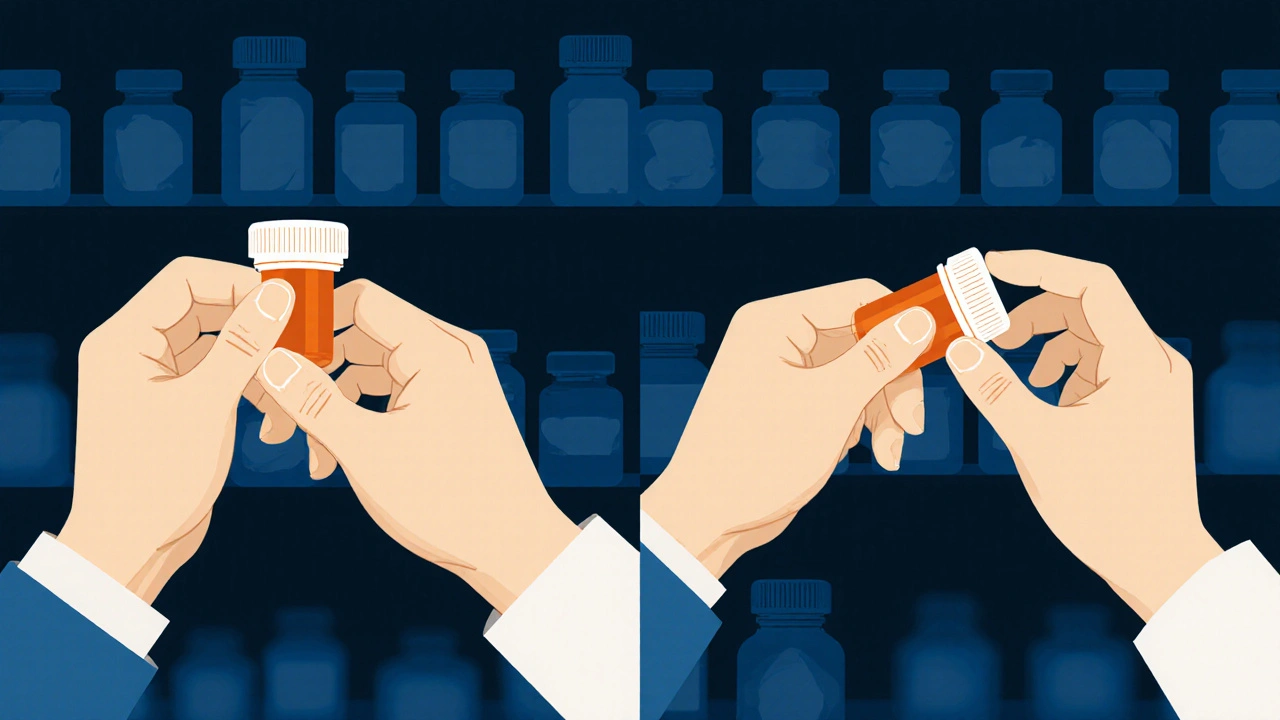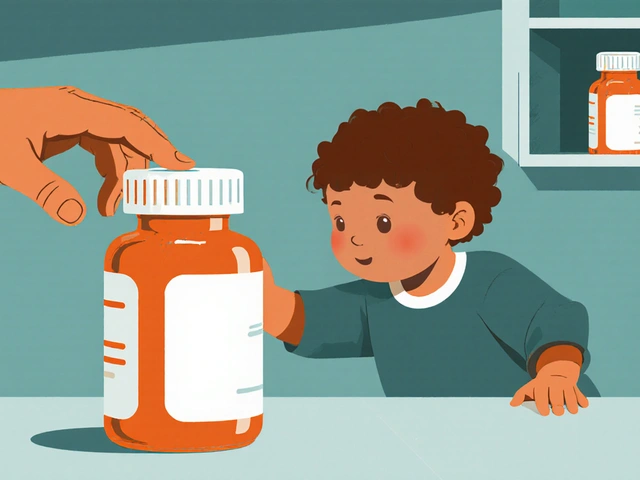Every year, over 12,000 children in the U.S. end up in emergency rooms after accidentally swallowing medicine they shouldn’t have. Most of these incidents happen because a child got into a bottle that looked like it was sealed tight-but wasn’t. That’s where child-resistant packaging comes in. It’s not magic. It’s not foolproof. But it’s one of the most effective tools we have to keep kids safe from accidental poisonings.
What Exactly Is Child-Resistant Packaging?
Child-resistant packaging, or CR packaging, is any container designed to be hard for kids under five to open-but still easy enough for most adults to use. The key word here is resistant, not proof. No cap is completely child-proof. A determined child with time, patience, or help from an older sibling can still get in. But good CR packaging makes it hard enough that most kids won’t succeed within 10 minutes, which is usually long enough to stop them before they swallow something dangerous. This isn’t new. The system started in 1970 with the Poison Prevention Packaging Act (PPPA). Back then, over 5,000 children died from accidental poisonings in just six years. That number dropped by nearly half after CR packaging became standard. Today, it’s required for most prescription drugs, many over-the-counter medicines, pesticides, and even some household cleaners.How Do These Caps Actually Work?
You’ve seen them: the cap that won’t twist off unless you push down first. Or the one that needs you to squeeze and turn at the same time. These aren’t random designs-they’re the result of strict testing. The U.S. Consumer Product Safety Commission (CPSC) tests every design on two groups:- 50 children between 42 and 51 months old
- 100 adults aged 50 to 70
- Push-and-turn: You press down on the cap while twisting. This is the most common type for pills and capsules.
- Squeeze-and-turn: You squeeze the sides of the cap while twisting. Often used for liquid medicines.
- Interlocking caps: Two parts must move in different directions at once.
Not All Medicines Are Created Equal
CR packaging works better for some forms of medicine than others. Solid pills and capsules? Almost always compliant. Over 97% of prescription pill bottles meet the standard. But liquids? That’s where things get messy. About 39% of non-compliant packaging incidents involve liquid medications. Why? Because the caps on liquid bottles often have to be leak-proof, which makes them harder to design for both child resistance and senior ease. Some parents use droppers or syringes that come with the medicine-and those don’t always have CR caps. Nasal sprays are another headache. The CPSC says the spray pump itself doesn’t count as child-resistant. So if the cap is just a plain plastic cover, it doesn’t meet the rules. Manufacturers now have to add a CR overcap or redesign the whole pump mechanism. Only about 22% of nasal sprays were compliant before these changes. Blister packs are an alternative. But standard blister packs-where you just push a pill through foil-don’t count. To be CR, the foil must require at least 15 pounds of force to break through. That’s like pressing down with your whole hand, not just a fingertip. Some newer blister packs now include a flip-top cover that requires a push-and-turn motion to open.
Who Struggles the Most with These Caps?
CR packaging saves lives-but it can also make life harder for older adults and people with arthritis or hand weakness. A 2022 survey by the Arthritis Foundation found that 68% of people with hand mobility issues had trouble opening medication bottles. Many reported needing help from family members or resorting to using scissors, pliers, or even filing down the caps. The CPSC’s own testing says seniors should be able to open the cap in under 5 minutes. But real-world use is different. Some caps require up to 8 pounds of force to open. The recommended maximum for seniors is 5 pounds. That gap means thousands of older people are either skipping doses, leaving caps loose, or storing meds in unsafe places. That’s why some manufacturers now make “senior-friendly” CR caps. These use easier grip textures, wider edges, or lever mechanisms. One Amazon product, Blisterpak’s Easy-Open system, has a 4.2 out of 5-star rating from over 1,200 users-many of them caregivers for elderly parents.Why Do Kids Still Get Into Medicine?
Even with CR packaging, kids still access medicine. In 2022, over 12,800 cases were reported to poison control centers. The biggest reason? Improper reclosing. About 73% of incidents happened because the cap was put back on wrong-pushed but not turned, or twisted but not pushed down. Parents think it’s locked. It’s not. Another 18% happened because the container was damaged. A cracked cap, a broken seal, or a bottle that got dropped and warped can turn a CR package into an open door. Testing by Consumer Reports in 2023 showed big differences between brands. Caps made by big pharmaceutical companies passed child resistance tests 92% of the time. But store-brand or generic caps failed 22% of the time. That’s a huge gap. Just because a bottle says “child-resistant” doesn’t mean it actually is.What Happens If a Company Doesn’t Follow the Rules?
Pharmaceutical companies must prove their packaging passes CPSC testing before selling it. They submit detailed documentation to the FDA as part of the eCTD (Electronic Common Technical Document), with exact wording: “We verify in this submission that the following package meets CPSC’s standards under 16 CFR 1700.” Testing costs between $8,500 and $15,000 per design. It’s expensive-but not as expensive as a lawsuit or a child’s death. If a company sells non-compliant packaging, they risk FDA warning letters, product recalls, or civil penalties up to $100,000 per violation. Even pharmacies can get in trouble. A 2022 survey found that nearly half of veterinary clinics were giving out medications in non-CR bags or envelopes. That’s a violation too. If a child gets into a medicine dispensed by a vet, the clinic can be fined.
What’s Changing in 2025?
The rules are still evolving. In 2023, the CPSC proposed new rules for concentrated cannabis edibles-any product with more than 2mg of THC per serving now needs CR packaging. That’s because kids are eating them like candy. Laundry detergent pods are another target. Right now, they’re only covered by voluntary standards. But after hundreds of child poisonings, the CPSC is moving toward mandatory CR packaging. Even vitamin D supplements are under review. High-dose versions (over 4,000 IU per tablet) are now being considered for CR packaging because accidental ingestion can cause serious toxicity in young children. Globally, countries are catching up. Brazil made CR packaging mandatory for all medications in 2021. India followed in 2022. The EU uses similar standards under EN ISO 8317:2023, though their senior-friendly requirements are less strict than the U.S.’s.What Should You Do as a Parent or Caregiver?
CR packaging is a safety net-but it’s not a substitute for good habits. Here’s what actually works:- Always re-close properly. Push down and twist until you hear or feel a click. Don’t assume it’s locked.
- Store meds up and away. Not on the counter, not in a purse, not in a drawer kids can reach. High cabinets with locks are best.
- Don’t rely on one layer. Use CR caps + locked storage + supervision. Layered safety saves lives.
- Ask for easier caps. If you or a loved one struggles to open them, ask your pharmacist for a senior-friendly version. Most pharmacies will switch to non-CR caps if you sign a waiver.
- Check expiration dates. Old caps can crack or warp. Replace them if they look damaged.
Final Thoughts
Child-resistant packaging isn’t perfect. But it’s one of the few public health tools that actually works. Since 1970, it’s prevented an estimated 900,000 pediatric poisonings every year. That’s not a statistic-it’s 900,000 children who didn’t end up in the ER. The real challenge now isn’t making caps harder for kids. It’s making them easier for seniors, people with disabilities, and caregivers who are already stretched thin. The future of medication safety isn’t just about locking things away. It’s about designing systems that protect everyone-kids and grandparents alike.Are child-resistant caps really effective?
Yes, but not perfectly. Studies show CR packaging prevents at least 85% of children under five from opening a container within 10 minutes. Since the 1970s, it has reduced pediatric poisoning deaths by 45%. However, it doesn’t stop all incidents-especially if the cap isn’t re-closed properly or if the container is damaged.
Can I ask my pharmacist for easier-to-open caps?
Yes. If you or a family member has arthritis, limited hand strength, or other mobility issues, you can request non-child-resistant packaging. The pharmacist will ask you to sign a form acknowledging the risks, but this is legal and common. Many pharmacies keep a supply of easy-open bottles on hand.
Why do some medicine bottles still have child-resistant caps even if they’re not dangerous?
Some medications are packaged in CR containers because they contain ingredients that are hazardous in high doses-even if they’re generally safe at normal levels. For example, iron supplements, certain pain relievers like acetaminophen, and even some cough syrups can be toxic if a child swallows multiple doses. The CPSC sets thresholds for active ingredients that trigger the requirement.
Do all countries require child-resistant packaging?
No, but many do. The U.S., Canada, the EU, Australia, Brazil, and India all have mandatory CR packaging laws for certain medications. Standards vary slightly, but most follow international guidelines like ISO 8317. Some countries, like Japan, rely more on labeling and education than physical barriers.
What should I do if my child opens a CR cap?
If you suspect your child has swallowed any medication, call Poison Control immediately at 1-800-222-1222 (U.S.) or your local emergency number. Don’t wait for symptoms. Even if you think they didn’t swallow anything, it’s better to be safe. Keep the container handy-the ingredients listed on the label help poison control give you the right advice.



Skye Hamilton
November 27, 2025 at 20:38so i just leave all my meds on the counter cause honestly who cares if the kid opens it theyll just spit it out right? like its not like theyre gonna die from a tylenol or whatever
Brandon Trevino
November 27, 2025 at 23:37The data presented is statistically significant but methodologically flawed. The CPSC's 85% child resistance threshold is arbitrary and lacks longitudinal validation. Moreover, the 90% senior accessibility metric ignores biomechanical variance across geriatric populations. This is not safety engineering-it's regulatory theater.
Jacob Hepworth-wain
November 28, 2025 at 14:41Really appreciate this breakdown. I've seen so many families struggle with these caps-my grandma used to leave her blood pressure meds open because she couldn't twist them. She'd just put them on the windowsill. Scary stuff. Glad there's progress on senior-friendly designs.
Craig Hartel
November 29, 2025 at 16:56It's wild to think that something as simple as a bottle cap has saved nearly a million kids. I never realized how much engineering goes into this. The Bluetooth cap thing is next level though-imagine getting a text at 3am because your toddler just opened the Advil. Parenting just got a new notification.
Olivia Gracelynn Starsmith
November 29, 2025 at 23:01Child-resistant packaging is essential but insufficient. The real issue is caregiver complacency. Over 70% of incidents occur because the cap was not properly secured. Education must accompany engineering. Always double-check the click. Always.
Graham Moyer-Stratton
December 1, 2025 at 20:28America is soft. We design caps for kids instead of teaching parents to watch their damn children. Other countries don't need this nonsense. We made the problem by being lazy.
tom charlton
December 1, 2025 at 23:44Thank you for this comprehensive overview. The data on generic packaging failures is particularly alarming. Pharmacies must be held accountable for dispensing non-compliant containers. Patient safety cannot be compromised for cost savings. I urge all healthcare providers to audit their packaging protocols.
Chris Kahanic
December 2, 2025 at 21:53Interesting how blister packs are treated differently. I always assumed the foil was enough. 15 pounds of force? That's like trying to crush a soda can with your palm. Makes sense though. Still, I've seen seniors break their nails trying to pop pills out.
Geethu E
December 4, 2025 at 09:23India just made it mandatory last year and honestly it's been a game changer. Before, kids were opening cough syrup bottles like they were candy jars. Now, even the small clinics are using CR caps. Still some people complain about difficulty opening but better safe than sorry. My niece almost swallowed half a bottle of iron pills last year-thank god the cap held.
anant ram
December 5, 2025 at 12:00Let me just say, I am so grateful for this post. It's so important to understand that CR packaging isn't magic-it's a tool. And like any tool, it needs to be used correctly. Always push AND turn. Always store up high. Always check for cracks. And if you're struggling, ask for help-no shame in that.
king tekken 6
December 5, 2025 at 21:56you know what's really scary? the fact that the FDA approves these caps but the same people who sign off on them also let big pharma sell opioids like candy. so we're protecting kids from tylenol but letting them OD on oxycodone? that's not safety. that's hypocrisy.
DIVYA YADAV
December 7, 2025 at 11:08This whole child-resistant thing is a government scam. They want us to think we're safe, but they're really just controlling what we keep in our homes. Did you know that the same companies that make these caps also make the pesticides and cleaning chemicals that are even more toxic? And now they're pushing it on vitamin D? Next they'll make your toothpaste child-resistant. It's all about control. Wake up.
Kim Clapper
December 9, 2025 at 07:12It's not the caps that are the problem-it's the fact that we've turned parenting into a compliance checklist. We've lost the art of vigilance. We rely on a twist of plastic instead of teaching our children boundaries. My child knows not to touch medicine because I told her, not because of a CPSC standard. That's real safety.
Bruce Hennen
December 9, 2025 at 11:29The phrase "push-and-turn" is incorrectly used in the article. It should be "press-down-and-rotate." Precision matters in technical communication. Also, the CPSC does not test on children aged 42-51 months; it tests on children aged 42 to 51 months inclusive, which is correct-but the article's punctuation is inconsistent. This undermines credibility.
Jake Ruhl
December 9, 2025 at 22:25Okay so I just looked up what happens if a kid eats a whole bottle of melatonin and now I'm in a full panic. Like, I thought it was just sleep stuff but apparently it can cause seizures and coma and like... why is this even legal? And why are we still using these stupid caps that only work if you actually remember to twist them? My mom leaves hers open all the time because she says it's too hard and she's 72 and I just wanna cry. Also I think the government is lying about how many kids get into meds because they don't want to admit how bad it is. I just found a Reddit thread where someone said their kid opened a bottle of Adderall and the ER doctor said "this happens every week." EVERY WEEK. Like what are we even doing here?